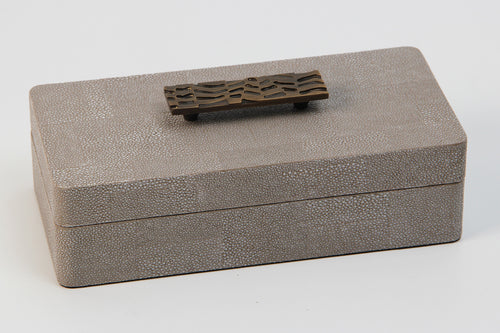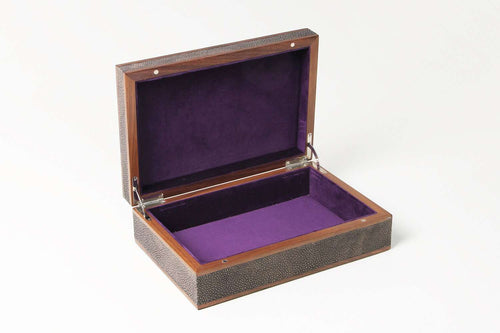Jewellery has been made and worn almost since man began to walk the earth. The earliest jewellery was made from pieces of bone and seashells with a hole drilled through and threaded onto a piece of string to form bracelets and necklaces. We still find remains of this jewellery in burial pits. We can assume that the jewellery was worn permanently or kept in a pouch if not in use.
As civilizations grew and people settled down to a more fixed urban life, the wealthy began to collect jewellery. They therefore needed a container to store it and thus begins the story of the jewellery box!

A brief history of the jewellery box
Jewellery boxes were in common use by the Egyptians in 5000BC. Wealthy Egyptians, both male and female, liked to adorn themselves with beautiful jewellery. They had a fondness for gold and semi-precious stone such as Lapis Lazuli. These early boxes were also security for valuable treasures and were often fitted with locks.
By the middle ages in Europe, before the arrival of safes and deposit boxes, a strongbox was required for the security of ones valuables. Iron was the most secure material of the time. Therefore, the boxes were normally made of wood (often covered in leather) and bound with iron bands and a lock.
At this time the jewellery box became part of the courting ritual with the prospective groom buying a box (they were made with blank crests so the groom could fill in his own) and either filling it with jewellery or maybe just the promise of jewellery to come as a gift for his prospective bride for her engagement.

Ansley Jewellery Box in Mulberry Shagreen

Ansley Jewellery Box in Pink Shagreen

Ansley Jewellery Box in Silver Boa

Ansley Jewellery Box in Teal Shagreen

Avalon Jewelry Box in Barley Shagreen
What is a jewellery box?
Jewellery boxes are really the container for storing jewellery. They are often also called treasure boxes, trinket boxes, jewellery chests, treasure chests or jewellery caskets. They are all basically the same thing with chests and caskets normally being larger.
The Romans were also fond of their jewellery. It became a status symbol for the rich and powerful with only certain ranks being permitted to wear rings and other luxury accessories.
Another important piece of jewellery for the Romans was the broach being designed to hold their clothing together. All this jewellery required safe storage. This meant the jewellery box was quite common in this period.
In the eighteenth century, the jewellery box got bigger with Marie-Antoinette being presented a box the size of a small table made of tulip wood and embellished with floral porcelain plaques. This was a wedding present from Louis XVI. The box, however, was not big enough as by tradition a queen inherited all the jewellery of previous Queens. Therefore, Marie-Antoinette had to order something a little bigger. Her new ‘Diamond Cabinet’ was eight foot high and six-foot-wide and covered with gilt, sea-green marble and mother of pearl. It was a gigantic piece of jewellery in itself!
By 1900 mass-produced gold and silver boxes were very popular. Souvenir and commemorative boxes with ceramic discs of photos became collectibles. In America, the mail order catalog became a popular method of purchase for jewellery opening the product to a much wider market than ever before and of course, increasing the demand for the jewellery box.

Avalon Jewellery Box in Seal Brown Shagreen

Deco Jewellery Box with Brass

Deco Jewellery Box with Silver Trim
The Forwood Design luxury jewellery box collection
However nowadays, the jewellery box is more than just a storage box for jewels and other trinkets. It has become a luxurious accessory in its own right.
The Deco Jewellery Box has a removable walnut tray lined in crimson red suede, a beveled vanity mirror and a necklace pouch.
The Avalon Jewellery Box comes with two layers and a removable sliding tray which allows the owner to see their entire collection of valuables at one time. It also has a vanity mirror in the lid and comes with a lock and keys.
The Ansley Jewellery Box is slightly smaller than the Avalon and has a small removable tray and a vanity mirror.
Our Treasure Boxes which are a little smaller than the Ansley box are beautifully made in faux shagreen and lined with suede.
The Sophie Box comes in a wide variety of finishes including linen, tortoiseshell, malachite and shagreen. This is a very versatile box trimmed with brass and surmounted with a beautiful brass pebble.
We have also collaborated with the acclaimed interior designer Rachel Winham to produce a larger Treasure Box in shagreen with a beautiful antiqued brass handle in a herringbone pattern with a modern twist. This design of this box is on the large side so as to be able to hide unsightly TV remote controls.

Rachel Winham's 'Dune' Treasure Box

Rachel Winham's 'Linen White' Treasure Box

Rachel Winham's 'Midnight' Treasure Box

Treasure Box in Coral Shagreen

Treasure Box in Seal Brown Shagreen
How do you spell jewellery?
Some word facts. In England and Australia the spelling of the word has a double L – Jewellery. Whereas the word in America includes just one L – Jewelry. Canada accepts both spellings, but Jewelry is more commonly used.
This rule also applies to the derivatives of the word, so you have jeweller / jeweler, jewelled / jeweled, jewelling and jeweling. The exception to the rule is jewel, which is spelt with a single L by all.

